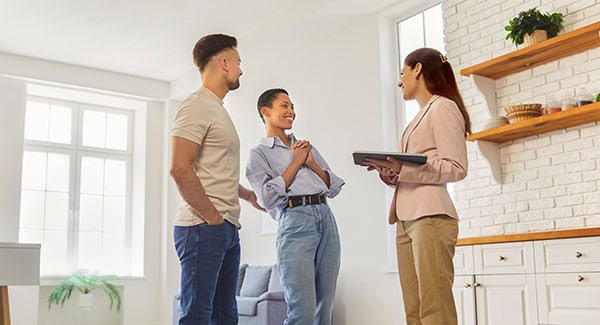
Last Updated on October 9, 2023
Shopping for homes before realistically evaluating your monthly capacity to service a mortgage is like falling in love with a golden retriever puppy before you’ve read the rental property contract clause about pet ownership. And that’s no fun, my friends.
Many times buyers fall head-over-heels in love with a home only to realize it’s way over their budget.
So for all of us who’ve been told not once, but maybe more than a few times that we have champagne dreams on a beer budget, this process is for you. Don’t hit the panic button just yet— here’s how to make sure your new home doesn’t break the bank.
How much house can I afford?
Finance experts suggest home buyers follow a pretty simple formula— the 33/45 rule— when it comes to calculating how much house you can afford.
The first step in the exercise is to figure out your monthly gross income (this is your income before taxes). Once you have that number down, figure out what 33% of your gross monthly income would be. That’s the number you’ll want to stick to (or below) when it comes to budgeting for your mortgage, taxes and insurance (more about this below).
For example with a monthly income of $5,000, 33% is $1,650. That is the maximum payment for mortgage, taxes and insurance.
Now let’s examine the 45 portion of the rule. Experts suggest you should have no more than 45 percent of your gross income tied to debt— think car loans, that pesky student loan debt, and now, your new house. If you have any additional monthly debt with the 33/45 rule, the most in additional monthly debt you could have would be $600 to keep it within the total debt limit, which in this case is $2,250.
Factor in the down payment
Coming up with a hefty down payment can be tricky— especially when you’re just starting out and things like student loans are hampering your saving efforts. And while most mortgage experts will recommend you come to the table with 20% down, they’re also human and they don’t expect many first-time homebuyers to have that amount of cash laying around.
A mound of financing options— some requiring as little as 3.5% down— exist for first-time homebuyers who may struggle to come up with the necessary funds. Keep in mind though that financing options that don’t require the full 20% down do come with a not-so-fun counterpart— PMI, or private mortgage insurance, which is designed to protect the lender in the case of default.
PMI is typically .3 to 1.5% of the original loan value and is usually paid monthly. All that to say, if you aren’t prepared to come to the closing table with 20% down, be sure to factor in PMI when figuring out how much you can afford. PMI is definitely not a deal breaker, just something to be aware of when calculating how much you can afford.
Consider your mortgage options
If you’re feeling like you can’t come to the closing table with 20% down, don’t sweat it. Loan options exist for virtually every buyer and budget. Here’s a brief snapshot of some of the most common loan options:
USDA loan
If you’re considering purchasing a home and are struggling to come up with a hefty down payment, you may qualify for a zero down, USDA loan. The home you purchase must fall within an eligible rural area that’s defined by the USDA and you must meet certain income requirements. Check with your mortgage officer if you’re interested in learning more about a USDA loan.
VA loans
For Veterans, Service Members and select military spouses, VA loans offer zero down payment and no PMI.
FHA loans
For many first time homebuyers, FHA loans make purchasing a home easy. FHA loans offer down payment options as low as 3.5%, low closing costs and are typically easier for first time buyers to qualify for.
Conventional loans
Established by Freddie Mac and Fannie Mae, conventional loans offer programs to qualifying homebuyers for as little as 3%.
Factor in closing costs
Often times one of the biggest shock to first time homebuyers is realizing that they’ll need to come to the table with closing costs, as well as their down payment.
Closing costs can range anywhere from 2 to 5 percent of the total purchase price of the home, and include fees related to the purchase of your home. Here’s everything you wanted to know about closing costs, if you’d like to learn more.
Don’t forget about homeownership costs
Planning for unexpected expenses is my least favorite thing, and I’m sure yours too, but when you’re a homeowner, being disciplined with this practice can save you from dipping into savings or giving Mom and Dad a ring.
Experts advise homeowners set aside between 1-4% of the home’s total value for maintenance and repairs each year. That way, when an unplanned expense arises, you won’t be caught off guard!
Get pre-approved for a mortgage
If you’re in the process of shopping for homes, chances are you’ve heard the terms pre-approval and pre-qualification. And if you’re like most of us, you have no clue what the difference between the two are.
Now hear this: Pre-approval is the only term you need to concern yourself with if you’re serious about buying a home. This is the whole enchilada, the whole nine yards, the hook, line and sinker, so to speak. So If you want to buzz right past the hordes of other first-time homebuyers, and figure out down-to-the-penny what you can afford, get pre-approved.
Obtaining a pre-qualification can be a good starting point and can be done quickly. If you are a salary-only buyer with your own funds to close, it will allow the lender to run your credit and give you a ballpark of what you can look at. However, a pre-approval is always preferred by sellers in this tight inventory market.
Complete the process by meeting with your mortgage partner who will walk you through all the necessary paperwork and details. Once you know what you’re pre-approved for, you can shop for homes with confidence.
Work with a buyer’s agent
After you’ve figured out how much you can afford and taken the necessary steps to get pre-approved, it’s time to shop for homes.
Working with a buyer’s agent to navigate the home buying process is a good idea, as you’re going to be navigating a complicated process.
A buyer’s agent will work with you to identify homes in your price point and desired area. When it comes time to write up an offer, a buyer’s agent will use their market knowledge and comparable home sales to help you write the most competitive offer.
Finally, when you’re ready to do some negotiating, you can relax and let your expert do all the heavy lifting, negotiating like a pro with your best interests in mind.
Ready to find a Realtor and shop for homes? Let us help!



